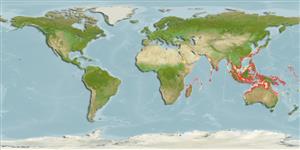Environment: milieu / climate zone / depth range / distribution range
Ökologie
seewasser; brackwasser demersal; amphidrom (Ref. 51243); tiefenbereich 1 - 40 m (Ref. 3424). Tropical
Indo-West Pacific: coasts of India and Sri Lanka to China; south to Australia.
Length at first maturity / Size / Gewicht / Alter
Maturity: Lm 18.1 range ? - ? cm
Max length : 18.2 cm FL Männchen/unbestimmt; (Ref. 46605); common length : 11.0 cm TL Männchen/unbestimmt; (Ref. 3424)
Rückenflossenstacheln (insgesamt) : 8; Rückenflossenweichstrahlen (insgesamt) : 16; Afterflossenstacheln: 3; Afterflossenweichstrahlen: 14. Body silvery; live or fresh specimens with a golden gleam. Head naked; with nuchal spine. Protracted mouth pointing downward. Scales minute. 2nd dorsal spine less than 1/3 of body depth.
Lives in shallow waters down to depths of about 40 m, predominantly near the bottom, found in schools. Feeds mainly on diatoms, copepods, Lucifer, nematodes and polychaetes (Ref. 3424).
Life cycle and mating behavior
Maturities | Fortpflanzung | Spawnings | Egg(s) | Fecundities | Larven
Kühlmorgen-Hille, G., 1974. Leiognathidae. In W. Fischer and P.J.P. Whitehead (eds.) FAO species identification sheets for fishery purposes. Eastern Indian Ocean (fishing area 57) and Western Central Pacific (fishing area 71). Rome, FAO. Vol. II, pag. var. (Ref. 2108)
IUCN Rote Liste Status (Ref. 130435)
Bedrohung für Menschen
Harmless
Nutzung durch Menschen
Fischereien: kommerziell
Tools
Zusatzinformationen
Download XML
Internet Quellen
Estimates based on models
Preferred temperature (Ref.
123201): 24.6 - 29.2, mean 28.2 °C (based on 1182 cells).
Phylogenetic diversity index (Ref.
82804): PD
50 = 0.5039 [Uniqueness, from 0.5 = low to 2.0 = high].
Bayesian length-weight: a=0.01318 (0.00799 - 0.02176), b=2.99 (2.84 - 3.14), in cm total length, based on LWR estimates for this species & (Sub)family-body (Ref.
93245).
Trophic level (Ref.
69278): 3.0 ±0.33 se; based on food items.
Widerstandsfähigkeit (Ref.
120179): hoch, Verdopplung der Population dauert weniger als 15 Monate. (K=0.90-1.75).
Fishing Vulnerability (Ref.
59153): Low vulnerability (15 of 100).
